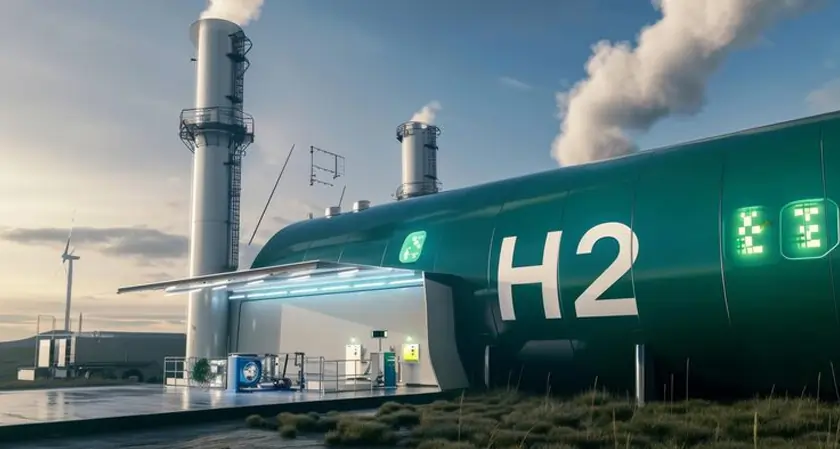Home Industry Clean Energy The Rise of Green Hydrogen: A ...
The Rise of Green Hydrogen: A Game Changer for Clean Energy?
Clean Energy

Business Fortune
06 August, 2025
Green hydrogen is becoming a well-known, strong, and clean fuel for the future. It is produced by splitting water into hydrogen and oxygen using power from the sun or wind, producing a clean fuel. We might be able to reduce our need for gas and oil, generate good jobs, and power factories and automobiles with this new energy. It's not ideal yet, though, as it takes time to construct the proper equipment and make it inexpensive. We'll look at why green hydrogen could play a significant role in creating a cleaner, greener world in this blog.
The Science behind Green Hydrogen
Electrolysis, a process that uses electricity to separate water molecules into hydrogen and oxygen, is how green hydrogen is made. Green hydrogen is primarily distinguished from other forms by its electrical source. The electrolysis technique produces entirely pure hydrogen with no carbon emissions during manufacturing when using renewable energy. The electrolysis process uses electrolyzers, such as alkaline electrolyzers and proton exchange membrane devices. All types provide the same basic function of employing electrical current to separate water molecules, despite differences in cost structures and operating characteristics.
Hydrogen can be compressed and stored as a gas, used immediately as fuel, or liquefied for transportation. Water vapor is the only byproduct of burning hydrogen or powering a fuel cell. For situations where emissions must be completely removed, this makes it a desirable choice. Despite the relatively straightforward nature of the production process, efficiency is crucial. About 60–80% of electrical energy is normally converted into chemical energy stored in hydrogen bonds by current electrolyzers. Researchers are trying to lower the cost of equipment while increasing its efficiency.
Benefits of Using Green Hydrogen
Green hydrogen has more economic possibilities than just producing clean fuel. Countries can use their own solar and wind energy to generate their own electricity instead of importing expensive gas and oil. The job market seems to be becoming better overall. Equipment such as fuel cells and electrolyzers that produce hydrogen will require human labor. Production plants and pipes will be constructed by construction personnel. Facilities require operators and maintenance personnel to maintain everything functioning correctly once it is up and running. These positions typically pay well since they involve some technical skills.
What makes hydrogen interesting is its versatility. Businesses can use it to generate energy, heat buildings, power cars, or as a raw material for goods. Businesses no longer have to oversee several fuel suppliers and contracts as a result. Compared to conventional fuels, the price situation can be more advantageous. Electricity and equipment maintenance are your biggest expenses after building a hydrogen factory. Politics and market manipulation cause the price of gas and oil to fluctuate, while the price of hydrogen ought to be more stable.
Challenges of Green Hydrogen
The largest obstacle to the widespread use of hydrogen is still cost. Currently, the cost of producing green hydrogen ranges from $3 to $8 per kilogram, whereas the cost of producing hydrogen from natural gas is roughly $1 to $2 per kilogram. Without legislative assistance or carbon pricing that takes environmental costs into account, this price disparity makes it challenging for businesses to defend switching. The development of infrastructure necessitates a large initial expenditure. Transport and storage are impacted by the special characteristics of hydrogen. It can cause some metals to become brittle over time and seep through objects that contain other gases. This means that without modifications, it is frequently not possible to convert existing natural gas infrastructure directly for usage as hydrogen.
There are still technical issues in a few places. Electrolyzers need to become more resilient, efficient, and sensitive to changes in renewable energy input. The output of renewable energy varies throughout the day, yet current systems function best under stable operating circumstances. It is preferable to connect the generation of hydrogen with the availability of renewable energy by developing electrolyzers that have the ability to quickly ramp up and decrease output. Consideration must be given to safety considerations. An invisible flame is released by hydrogen, which can ignite at a variety of concentrations. Even though industrial hydrogen has an excellent safety record and safety systems are in place, new usage may not be immediately accepted by the public or approved by regulators.
Future Outlook
Green hydrogen is attracting increasing amounts of investment as more people become aware of its possibilities. Billions of dollars are being invested in new projects and technologies by businesses and governments. Green hydrogen is also being made safer and easier to utilize with the development of regulations and safety standards. Even while not every plan will work out, the current state of affairs is encouraging. If the technology continues to advance and costs continue to decline, green hydrogen may eventually play a significant role in our energy supply and consumption. We may be able to permanently abandon fossil fuels with their support.


































